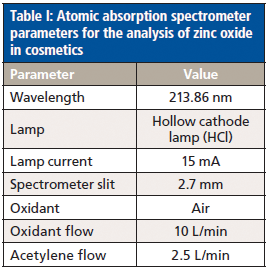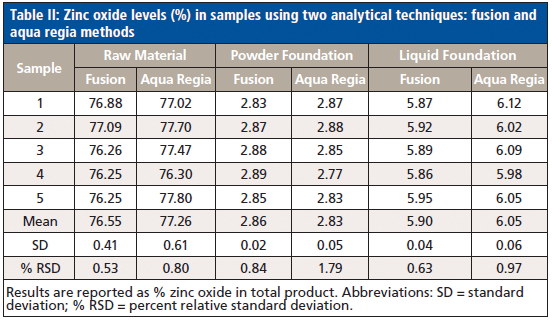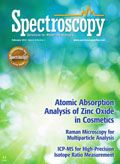A Rapid Extraction Method for Atomic Absorption Spectroscopy Analysis of Zinc Oxide in Cosmetics and Skin Care Products
Zinc oxide levels in cosmetic formulations are commonly analyzed by atomic absorption (AA) spectroscopy using the fusion method for sample digestion, a labor-intensive and time-consuming process that causes lengthy delays in product manufacturing.
Zinc oxide levels in cosmetic formulations are commonly analyzed by atomic absorption (AA) spectroscopy using the fusion method for sample digestion, a labor-intensive and time-consuming process that causes lengthy delays in product manufacturing. In this report, we describe an aqua regia digestion method that is an efficient and accurate method for preparing samples for AA analysis of zinc oxide content in cosmetics and skin care products that may also be automated for additional laboratory efficiency.
Zinc oxide is used as a sunscreen in a wide variety of cosmetics and skin care products. Its classification as an over-the-counter drug requires testing and analysis to support product label claims. The long standing and most widely used method for analyzing zinc oxide content in cosmetics and skin care products is the fusion method of sample digestion (1–3), followed by quantification using atomic absorption (AA) spectroscopy. The fusion method involves layering the sample with lithium metaborate in a platinum crucible, and heating it in a muffle furnace to create a fused sample–borate pellet. This process requires a lengthy preparation time (more than 3 h) in a quality assurance laboratory, resulting in delays in the batch release process for the manufacturing plant and putting both the plant and its personnel on standby until the data are available. Besides this lengthy analysis time, the fusion extraction method is very costly, requiring a large investment in platinum crucibles that deteriorate over time and necessitate either replacement or refurbishing.
In this study, we developed a sample digestion technique using a mixture of nitric and hydrochloric acids that when combined form nitrosol chloride (4,5), an oxidative acid mixture commonly known as aqua regia. Aqua regia digestion provides a less costly and more efficient (approximately 45 min per analysis) method for quantitating zinc oxide content in cosmetics and skin care products than the currently used fusion method.
Materials and Methods
Reagents and Materials
The raw material analyzed in this experiment was Velvet Zinc Oxide, a spray-coated material from Natural Finishes, with a specification of 75–80% zinc oxide. The finished products were Artistry Powder Foundation with a specification of 2.44–2.98% zinc oxide, and Artistry Pure White Moisturizer Liquid Foundation with a specification of 5.29–6.47% zinc oxide, both from Amway Global. Zinc standards were prepared using a 1000 ppm zinc stock solution (SPEX CertiPrep).
Lithium metaborate (Puratronic), nitric acid (Optima), hydrochloric acid (Optima), hydrogen peroxide (30%, ACS certified), sodium hydroxide (50%), and potassium iodide were purchased from Fisher Scientific. Lanthanum chloride was obtained from Sigma-Aldrich; 0.22 µm polyvinylidene fluoride (PVDF) filters were obtained from Whatman; and Digitube digestion vessels with caps were obtained from SCP Science.
Instruments and Equipment
The prepared sample digests were analyzed using a PerkinElmer AA400 atomic absorption spectrophotometer equipped with a zinc hollow cathode lamp. A carbon heat block with a variable thermostat was used to heat the samples for aqua regia sample digestion. A muffle furnace (Thermolyne Model 30400) and 25-mL platinum crucibles (Cole-Parmer) were used for the fusion digestion process. All other instruments used were standard laboratory equipment.
Aqua Regia Method: Digestion and Sample Preparation
The zinc oxide samples (raw material and both cosmetic foundations) were weighed (0.15–0.45 g) into 50-mL digestion tubes containing 10% potassium iodide (4 mL) and 1 N iodine (0.5 mL) solutions; being careful to avoid sample contact with the sides of the tubes to ensure consistent results. Aqua regia digestion was initiated by first pipetting concentrated hydrochloric acid (3 mL) into the sample solution followed by concentrated nitric acid (1 mL). (Note: aqua regia is unstable and should not be pre-mixed or stored in a closed container. As with all acids, aqua regia is very reactive and should be handled with caution.) The samples were heated for 10 min in a 100 °C heat block, and then the digestion tubes were removed and allowed to cool to room temperature. A 30% solution of hydrogen peroxide (1 mL) was slowly added to the cooled sample and the digestion continued for 5 min in a 70 °C heat block. The samples were again cooled to room temperature, and the 70 °C digestion step was repeated two additional times, adding 2 mL of 30% hydrogen peroxide for the last sample digestion. Finally, the samples were cooled to room temperature, diluted to a 50-mL volume with deionized water, mixed thoroughly, and passed with a syringe through a 0.22-µm PVDF filter. Before analysis, the samples were diluted 25–50-fold using a 4% nitric acid solution and then transferred to a 15-mL centrifuge tube for AA analysis.
Fusion Method: Digestion and Sample Preparation
Lithium metaborate (1.5 g) was weighed into a 25-mL platinum crucible, the sample was then weighed (0.5–0.9 g) onto the lithium metaborate, and a 50% solution of sodium hydroxide (0.5 g) was added to the crucible. The crucible was heated on a hotplate, which was set at the highest temperature, until the sample no longer released any visible vapors (at least 45 min). The sample was then covered with additional lithium metaborate (1.0 g) and the crucibles were placed in a cool muffle furnace. The furnace, containing samples, was heated to 900 °C and the temperature was held for 15 min. Each hot crucible was removed from the muffle furnace, placed on a preheated clay triangle, and a few crystals of potassium iodide were added. Using tongs, the contents of the crucible were gently swirled; after a few seconds, the crucible was lowered into a 250-mL beaker containing a mixture of deionized water (100 mL), concentrated hydrochloric acid (20 mL), and 30% hydrogen peroxide (10 mL). The crucible and mixture were stirred with a glass rod, covered with a watch glass, and heated to boiling until the sample pellet was completely dissolved. The mixture was then cooled to room temperature, quantitatively transferred to a 250-mL volumetric flask, and brought to volume with deionized water. A 2-mL aliquot was transferred to a 200-mL volumetric flask, and then hydrochloric acid (8 mL) and hydrogen peroxide (4 mL) were added and the mixture was brought to volume with deionized water. A subsample was placed into a 15-mL centrifuge tube for AA analysis.
Measurement of Prepared Zinc Oxide Samples
Prepared samples from both digestion methods were analyzed using a Perkin-Elmer AA400 atomic absorption spectrophotometer equipped with an autosampler. The instrument was configured to analyze samples in the air-acetylene mode. The AA operating parameters are listed in Table I. Each sample was prepared and analyzed five separate times for each digestion method. The spectrophotometer was set to take three sample readings and report the average result. A standard curve (0.25, 0.5, 0.75, and 1.0 ppm zinc) was analyzed and samples were quantified using WinLab software (PerkinElmer).

Table I: Atomic absorption spectrometer parameters for the analysis of zinc oxide in cosmetics
Results and Discussion
The zinc oxide content in cosmetics and skin care products is usually analyzed using the lithium metaborate fusion method (2). This method takes more than 3 h to complete with the longest step being the fusion step. It requires platinum crucibles costing more than $3500 a piece, and a muffle furnace must be used to reach the temperature necessary to drive the fusion process. The fusion method also requires analysts to perform multiple steps and make several dilutions. All of these reasons result in a method that is time consuming, labor intensive, and expensive.
In this report, we demonstrate that zinc oxide analysis using an aqua regia digestion method is a more efficient technique and provides equally accurate results compared to the fusion method. The aqua regia digestion method requires less time than the fusion method (45 min compared to 3 h) and is performed using standard laboratory equipment. A comparison of the results between the aqua regia and fusion digestion methods for the repeated extractions of the three formulations (raw material and two types of foundation) is shown in Table II. These data demonstrates that the two digestion techniques produce results that are within ±0.05% of each other.

Table II: Zinc oxide levels (%) in samples using two analytical techniques: fusion and aqua regia methods
Preliminary experiments showed that the aqua regia digestion method was not as reliable for cosmetics that contain high amounts of clay material, such as deep foundations (data not shown).
We have also been able to automate the aqua regia extraction method in our laboratory using a DEENA automated sample digestion system (Thomas-Cain, Inc.).
Conclusion
The aqua regia digestion method is an efficient and accurate method for preparing samples for AA analysis of zinc oxide content in cosmetics and skin care products. This reproducible digestion method is faster, simpler, and more cost effective than the current fusion digestion method and provides equivalent results. In addition to analyzing for zinc content, the aqua regia extraction method could potentially be used to analyze for the content of other metals, but this was not investigated in this study. The aqua regia digestion method may also be automated for additional laboratory efficiency.
References
(1) C.O. Ingalmells, Anal. Chim. Acta52, 323–334 (1970).
(2) R. Bock, A Handbook of Decomposition Methods in Analytical Chemistry, (International Textbook Company, London, 1999), pp. 197–200, 416.
(3) B.D. Zehr and T.J. Zehr, Spectroscopy6, 44–47 (1991).
(4) M.I. Kisser, Digestion of Solid Matrices Part 1: Digestion with Aqua Regia, (NUA-Umweltanalytik GmbH, Austria, 2005).
(5) M. Chen and L.Q. Ma, Soil Sci. Soc. Am. J. 65, 491–499 (2001).
James M. Koedam is with Analytical Sciences at Amway Corporation, in Ada, Michigan. Direct correspondence to: James.Koedam@amway.com

Geographical Traceability of Millet by Mid-Infrared Spectroscopy and Feature Extraction
February 13th 2025The study developed an effective mid-infrared spectroscopic identification model, combining principal component analysis (PCA) and support vector machine (SVM), to accurately determine the geographical origin of five types of millet with a recognition accuracy of up to 99.2% for the training set and 98.3% for the prediction set.
Authenticity Identification of Panax notoginseng by Terahertz Spectroscopy Combined with LS-SVM
In this article, it is explored whether THz-TDS combined with LS-SVM can be used to effectively identify the authenticity of Panax notoginseng, a traditional Chinese medicine.